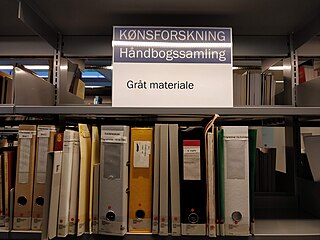Related Research Articles

The National Technical Information Service (NTIS) is an agency within the U.S. Department of Commerce. The primary mission of NTIS is to collect and organize scientific, technical, engineering, and business information generated by U.S. Government-sponsored research and development, for private industry, government, academia, and the public. The systems, equipment, financial structure, and specialized staff skills that NTIS maintains to undertake its primary mission allow it to provide assistance to other agencies requiring such specialized resources.
The United States National Agricultural Library (NAL) is one of the world's largest agricultural research libraries, and serves as a national library of the United States and as the library of the United States Department of Agriculture. Located in Beltsville, Maryland, it is one of five national libraries of the United States. It is also the coordinator for the Agriculture Network Information Center (AgNIC), a national network of state land-grant institutions and coordinator for the U.S. Department of Agriculture (USDA) field libraries.

The Office of Scientific and Technical Information (OSTI) is a component of the Office of Science within the U.S. Department of Energy (DOE). The Energy Policy Act PL 109–58, Section 982, called out the responsibility of OSTI: "The Secretary, through the Office of Scientific and Technical Information, shall maintain with the Department publicly available collections of scientific and technical information resulting from research, development, demonstration, and commercial applications activities supported by the Department."

The Spallation Neutron Source (SNS) is an accelerator-based neutron source facility in the U.S. that provides the most intense pulsed neutron beams in the world for scientific research and industrial development. Each year, this facility hosts hundreds of researchers from universities, national laboratories, and industry, who conduct basic and applied research and technology development using neutrons. SNS is part of Oak Ridge National Laboratory, which is managed by UT-Battelle for the United States Department of Energy (DOE). SNS is a DOE Office of Science user facility, and it is open to scientists and researchers from all over the world.

Grey literature is materials and research produced by organizations outside of the traditional commercial or academic publishing and distribution channels. Common grey literature publication types include reports, working papers, government documents, white papers and evaluations. Organizations that produce grey literature include government departments and agencies, civil society or non-governmental organizations, academic centres and departments, and private companies and consultants.

The Office of Intelligence and Counterintelligence (OICI), also abbreviated as IN, DOE-IN, DOE/IN, I&CI, or OIC, was established in 2006 by the merger of pre-existing Energy Department intelligence and security organizations. It is an office of the United States Department of Energy (DOE) responsible for all intelligence and counterintelligence activities throughout the DOE complex; due to this central role, OICI is designated DOE's Headquarters Intelligence. As a component of the United States Intelligence Community in addition to the Department of Energy, OICI reports to both the Director of National Intelligence and Secretary of Energy.
In the United States, a cooperative research and development agreement is an agreement between a government agency and a private company or university to work together on research and development.

A Next Generation Nuclear Plant (NGNP) is a specific proposed generation IV very-high-temperature reactor (VHTR) that could be coupled to a neighboring hydrogen production facility. It could also produce electricity and supply process heat. Up to 30% of this heat could be used to produce hydrogen via high-temperature electrolysis significantly reducing the cost of the process. The envisioned reactor design is helium-cooled, using graphite-moderated thermal neutrons, and TRISO fueled.
The Scientific and Technical Information (STI) Program of the National Aeronautics and Space Administration (NASA) collects, organizes, preserves, and releases the Agency's scientific and technical information. STI is derived from NASA's research and development efforts and NASA projects, programs, and missions. The program is essential in helping NASA avoid duplication of research, by sharing information to ensure that the U.S. maintains its preeminence in aerospace-related industries and education. Examples of NASA STI include technical papers and reports, contractor reports, conference papers and proceedings, journal articles, presentations, and technical information on websites. NASA STI also includes research information from NASA's predecessor agency, the National Advisory Committee for Aeronautics (NACA), which dates back to 1915 and transitioned to NASA at the advent of the National Aeronautics and Space Act of 1958 (Amended).

WorldWideScience.org is a global science search engine designed to accelerate scientific discovery and progress by accelerating the sharing of scientific knowledge. Through a multilateral partnership, WorldWideScience.org enables anyone with internet access to launch a single-query search of national scientific databases and portals in more than 70 countries, covering all of the world's inhabited continents and over three-quarters of the world's population. From a user's perspective, WorldWideScience.org makes the databases act as if they were a unified whole.
CENDI is an interagency group of senior Scientific and Technical Information (STI) managers from 14 United States federal agencies. CENDI managers cooperate by exchanging information and ideas, collaborating to address common issues, and undertaking joint initiatives. CENDI's accomplishments range from impacting federal information policy to educating a broad spectrum of stakeholders on all aspects of federal STI systems, including its value to research and the taxpayer, and to operational improvements in agency and interagency STI operations.
The Office of Science is a component of the United States Department of Energy (DOE). The Office of Science is the lead federal agency supporting fundamental scientific research for energy and the Nation’s largest supporter of basic research in the physical sciences. The Office of Science portfolio has two principal thrusts: direct support of scientific research and direct support of the development, construction, and operation of unique, open-access scientific user facilities that are made available for use by external researchers.
The Iraqi Virtual Science Library is an Iraqi Virtual Library providing Iraqi academics with access to recourses via the internet. The library, launched in May 2006, initially provided access to more than one million articles from 17,000 electronic journals and other resources. Access to this knowledge is considered vital for the rebuilding of Iraq as it will improve the curriculum which suffered under Saddam Hussein's regime. The library is part of the overall plan to improve access to information in Iraq.
Science.gov is a web portal and specialized search engine. Using federated search technology, Science.gov serves as a gateway to United States government scientific and technical information and research. Currently in its fifth generation, Science.gov provides a search of over 60 databases from 14 federal science agencies and 200 million pages of science information with just one query, and is a gateway to 2,200+ scientific websites.
Alvin Trivelpiece is a retired Director of Oak Ridge National Laboratory (ORNL), former Executor Officer of American Association for the Advancement of Science (AAAS), and former Director of the Office of Energy Research, U.S. Department of Energy (DOE). He has also been a professor of physics and a corporate executive. Throughout his varied career, Dr. Trivelpiece's research focused on plasma physics, controlled thermonuclear research, and particle accelerators. He has several patents on accelerators and microwave devices.
The Energy Citations Database (ECD) was created in 2001 in order to make scientific literature citations, and electronic documents, publicly accessible from U.S. Department of Energy (DOE), and its predecessor agencies, at no cost to the user. This database also contains all the unclassified materials from Energy Research Abstracts. Classified materials are not available to the public. ECD does include the unclassified, unlimited distribution scientific and technical reports from the Department of Energy and its predecessor agencies, the Atomic Energy Commission and the Energy Research and Development Administration. The database is usually updated twice per week.
Science Accelerator was a web-based gateway to science information including research results from the U.S. Department of Energy (DOE). The information was provided as a free public service by the DOE Office of Scientific and Technical Information (OSTI), within the Office of Science. It used federated search technology to search DOE-generated and DOE-related science information databases and collections. Federated search technology allowed the user to search multiple data sources with a single query in real time. It provided simultaneous access to "deep web" scientific databases, which were typically not searchable by commercial search engines.

The Networking and Information Technology Research and Development (NITRD) program consists of a group of U.S. federal agencies to research and develop information technology (IT) capabilities to empower Federal missions; support U.S. science, engineering, and technology leadership; and bolster U.S. economic competitiveness.
Tethys is an online knowledge management system that provides the marine renewable energy (MRE) and wind energy communities with access to information and scientific literature on the environmental effects of devices. Named after the Greek titaness of the sea, the goal of the Tethys database is to promote environmental stewardship and the advancement of the wind and marine renewable energy communities. The website has been developed by the Pacific Northwest National Laboratory (PNNL) in support of the U.S. Department of Energy (DOE) Wind and Water Power Technologies Office. Tethys hosts information and activities associated with two international collaborations known as OES-Environmental and WREN, formed to examine the environmental effects of marine renewable energy projects and wind energy projects, respectively.

Athena Safa Sefat, born 1977 in Iran is a Canadian/American physicist, with research focus on quantum materials and correlated phenomena. She was a senior scientist at Oak Ridge National Laboratory and led the DOE Basic Energy Science on "Probing Competing Chemical, Electronic, and Spin Correlations for Quantum Materials Functionality". She is currently a Program Manager at U.S. Department of Energy (DOE), Office of Science, Basic Energy Sciences, with Division of Materials Sciences and Engineering.
References
- ↑ U.S. Dept. of Energy (March 4, 2011). "Information Bridge: DOE Scientific and Technical Information - Home page". DOE Office of Science. http://www.osti.gov/bridge/index.jsp. Retrieved 2011-03-04.
- ↑ U.S. Dept. of Energy (March 4, 2011). "Office of Scientific and Technical Information – History Page". DOE Office of Science. http://www.osti.gov/ostihistory.pdf. Retrieved 2011-03-04.
- ↑ U.S. Dept. of Energy (March 4, 2011). "Office of Scientific and Technical Information – Home Page". DOE Office of Science. http://www.osti.gov/authority. Retrieved 2011-03-04.
- ↑ U.S. Dept. of Energy (March 4, 2011). "Office of Scientific and Technical Information – STI Program page". http://www.osti.gov/stip/ostiroles. Retrieved 2011-03-04.
- ↑ U.S. Dept. of Energy (March 4, 2011). "Information Bridge: DOE Scientific and Technical Information – FAQ". DOE Office of Science. http://www.osti.gov/bridge/faq.jsp#content. Retrieved 2011-03-04.
- ↑ U.S. Dept. of Energy (March 4, 2011). "Information Bridge: DOE Scientific and Technical Information - Home page". DOE Office of Science. http://www.osti.gov/bridge/index.jsp. Retrieved 2011-03-04.